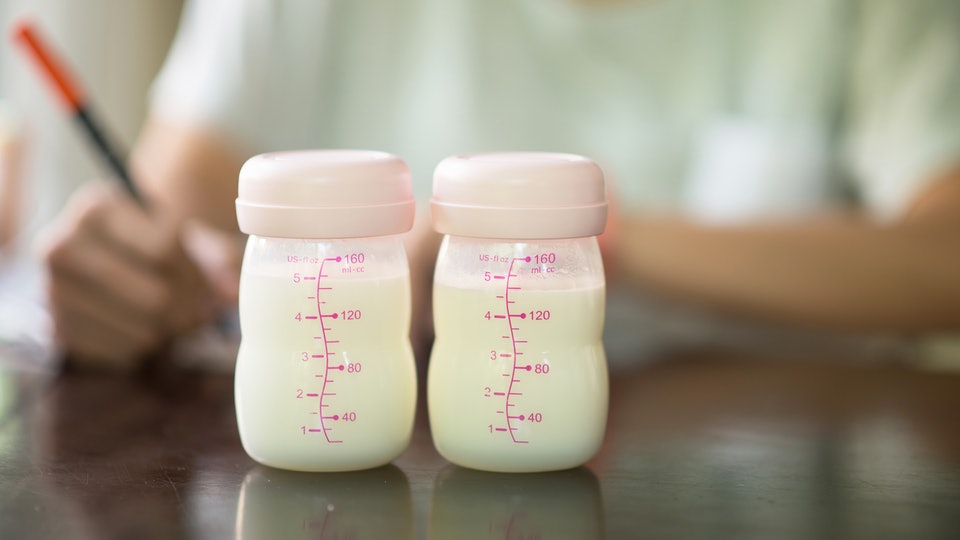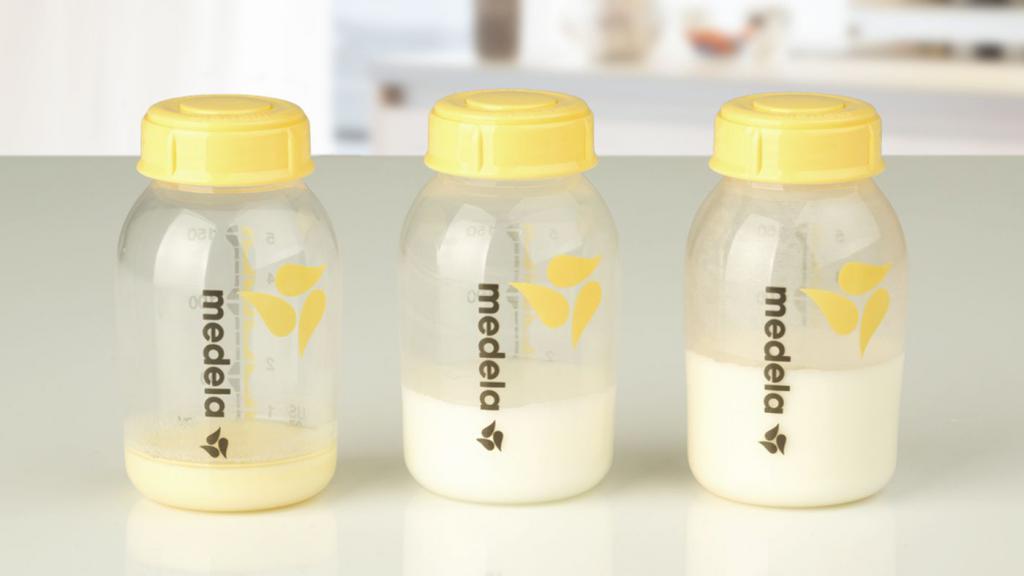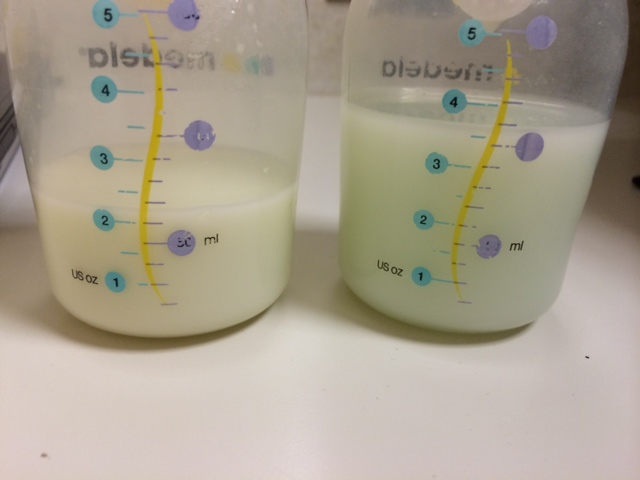In the article, we will consider what color should be breast milk.
Breast milk is a unique nutritious product that can change its smell along with color and taste at different periods of lactation. A change in the color of milk can be observed during the day, when certain physiological changes occur in the body of the nursing mother. Some nursing mothers show concern about the consistency of this product. The fat content of milk depends on different indicators. In the summer, milk becomes non-greasy, which is directly related to the need of newborns for additional fluid.

So, what color should be breast milk.
Colostrum color
Transitional milk of the mother appears immediately after the production of colostrum, which occurs even in the process of carrying the baby. Normally, colostrum has a yellow color with a cream tint, which is largely due to the high fat content.
The taste of colostrum can range from slightly salted to a sweet sensation. The color of the first breast milk interests many.
Transitional milk can acquire a white tint, and directly its consistency often becomes liquid. To evaluate the appearance along with the consistency of mother's milk, you can use the breast pump. Sometimes transitional milk has a yellowish tint, which is also considered the norm. The following factors affect the color of breast milk in a young mother:
- Features of the emotional and physical condition of women.
- Abuse of alcohol and smoking.
- The use of smoked meats, and, in addition, spicy and salty foods.
Mature milk color
What color should be breast milk, not everyone knows. The color scheme of maternal mature milk can be very variable. This indicator directly depends on the individual characteristics of the female body, and, in addition, on the area of the product in the mammary glands (posterior or anterior).

Back and front milk
Let's figure out what color breast milk should be, depending on whether it is front or back.
Anterior milk is closest to the excretory duct of the mammary glands. Such a product has a liquid consistency along with a transparent whitish tint. It contains vitamins, and in addition, milk sugar (i.e. lactose) and ordinary water. The function of the mother’s front milk is to fill the needs of the newborn in the required amount of fluid.
After fifteen to twenty minutes of active sucking, posterior milk begins to enter the duct, which already has a thick consistency with white color. This product contains a huge complex of nutritional components that fill the baby’s energy needs.
In the event that the baby refused the mother's breast and did not wait for the receipt of the back portion, the woman is not recommended to offer the child a second breast. When children consume only the front portions of milk, they develop an indigestion. For the same reasons, a slow mass gain among newborns is observed.
What is the color of breast milk if lactation ceases?
Upon termination of lactation
When it comes time to complete breastfeeding, mom's milk acquires a different consistency and a different color. The main function of such a product is the formation of immunity in the body of a newborn. At the stage of involution, breast milk is yellow, reminiscent of colostrum.
It is important to remember that the reason for the change in color is the use of certain drugs. The use of products that contain food coloring can also affect the coloring of the milk of a young mother. Next, let's try to figure out what color breast milk is normal.

The color of milk is normal
The bluish, white or yellow color of milk is the norm, the presence of these shades is often caused by changes in the milk composition at various stages of lactation. Colostrum usually has a yellow or orange hue. As for the color of mature breast milk (pictured), normally it is usually pale and a little blue. And at the natural end of lactation, milk turns yellow, after which it soon ceases to be completely produced. Now let's move on to the reasons why milk changes color.
Causes of milk color change
In some situations, a woman may find that her milk looks unusual, namely it has an unusual color. Here are the possible reasons for such changes:
- Change in diet. There are well-known cases when mother's milk turns green during periods of a woman consuming a large amount of greens, such as spinach, sorrel and sea kale. Vegetables that have bright colors, for example, carrots along with pumpkin and beets, can stain breast milk in pink or orange. If you consume a large number of berries, the product may turn blue or purple. It is worth noting that milk in this case does not pose any danger to the baby. The main thing is that he should not be allergic to products that became the reason for the color change.
- The effect of food colors. Artificial additives in foods or drinks that provide them with a bright color can also pass into breast milk, giving it an unexpected color. Often the culprits are all sorts of carbonated drinks, along with confectionery or sweets of too intense color. Such components can cause various digestive problems in babies, causing an allergic reaction.
- The effects of drugs. There are cases when mother's milk was stained black due to the use of medicines. With lactation, medications are allowed to be taken solely on the recommendation of a doctor and it is important to ensure that they are not contraindicated.
Yellow milk
Sometimes, in nursing women, the question may arise about why yellow milk appears. Women always have a moment when a young mother puts her baby to her breast. It should be noted right away that in no case should you worry about this type of color of the product, because the yellow color does not indicate its corruption or illnesses of the mother. Such a product of a newborn baby is allowed to feed.

In the event that a woman expresses milk at different times, it will be possible to notice a special pattern in the fact that she will also be of excellent color. Its color will begin to change, and, in addition, its composition. The fat content does not have to always be the same. It can change its properties every day or between decantation processes throughout the day. Having stared milk at the beginning of feeding, the woman will receive a bluish color of the product. And if milk is pumped at the end of feeding, then it will be more fat. Accordingly, the color will turn yellow.
The presence of pathological impurities in breast milk
With the development of a number of diseases in women’s breast milk, pathological impurities are observed. You can detect this while expressing milk. In the event that a nursing woman has found a change in the color of milk, she is recommended to seek the advice of a doctor, namely a mammologist.
What color is the woman’s breast milk normal, now it’s clear.
Impurity pus
In the event that impurities of pus in milk are found in women, this is a sign indicating the appearance of purulent mastitis. In this case, the woman will be able to continue breastfeeding, but only on condition that the discharge is insignificant.
In the event that the young mother had to give up breastfeeding for a while, she is recommended to express milk constantly. This will avoid stagnation and maintain lactation. In order to avoid the occurrence of congestion and mastitis, a nursing woman is recommended to apply a baby to her breast at his request.

Blood impurities
Blood veins are often observed during a rapid rush of milk. The cause of this condition is minor hemorrhage. Other causes of blood in breast milk include:
- Wearing tight underwear leading to prolonged squeezing of the breast.
- The appearance of abrasions and cracks in the nipple.
- The occurrence of bleeding caused by the proliferation of malignant and benign tumors of the mammary glands.
Before continuing to feed the baby with such food, a young mother should consult a specialist in order to find out the causes of bleeding. In some cases, a woman may need a course of drug treatment or surgery. Next, we will talk about purulent secretions and blood impurities in milk in more detail.
Not all women have an idea of what color breast milk is. A photo will help you figure it out.

What should alert you?
A change in color along with the consistency of breast milk in some cases can be a sign of a disease. In order to confirm or refute the suspicion, it is necessary to express milk, and, in addition, analyze its appearance. In the presence of alarming symptoms, you must consult a doctor. Below are examples of possible deviations in the health of the mother, which affect the color of milk.
Purulent discharge, as a rule, appears with the development of mastitis and the inflammatory process, which develop due to stagnation of milk in the duct. As a rule, pus discharge can be accompanied by a significant increase in body temperature, and, in addition, pain in the chest. Women should seek medical help in such cases. The possibility of subsequent breastfeeding is determined only by a doctor. In order to prevent the occurrence of mastitis, it is necessary to regularly apply the baby immediately to both mammary glands, expressing milk in case of suspicion of stagnation formed.
Milk of a greenish tint, which in addition is accompanied by a blood inclusion, can occur with a strong rush of fluid. This can happen if the feeding regimen is violated. And also, this happens when a nursing mother visits baths or saunas, and, in addition, against the background of excessive consumption of warm liquid. This can lead to a sharp increase in the amount of milk in the ducts and significant damage to small blood vessels, which is the main cause of color changes.

In the presence of a bleeding crack on the nipples, the milk also turns pink, but it is completely harmless to the baby. Especially dangerous is the condition in which blood enters the milk from a tumor in the breast. Such a woman is required to undergo an examination with a doctor, after which the doctor will prescribe therapy and decide on the advisability of further breastfeeding.
Thus, breast milk can be very different: liquid or watery, with a touch of blue, yellow and so on. But in the event of pus or blood impurities in this product, you should consult a doctor.
We examined what color breastmilk should be. Photo submitted.